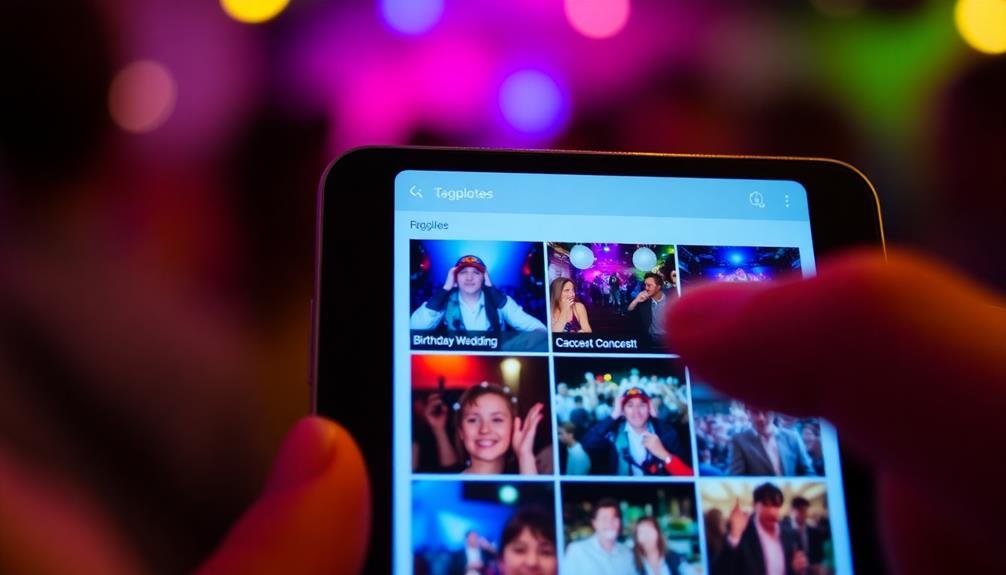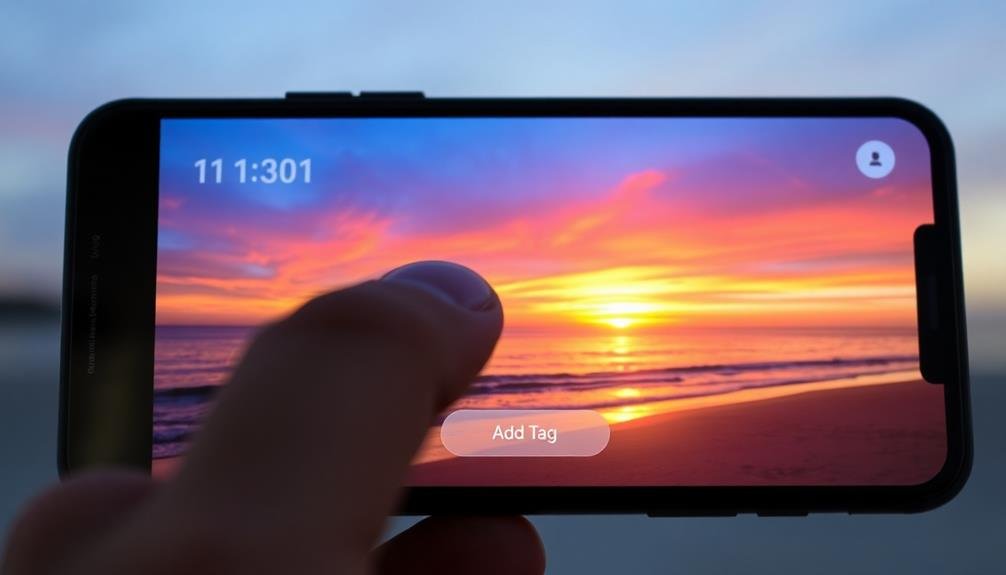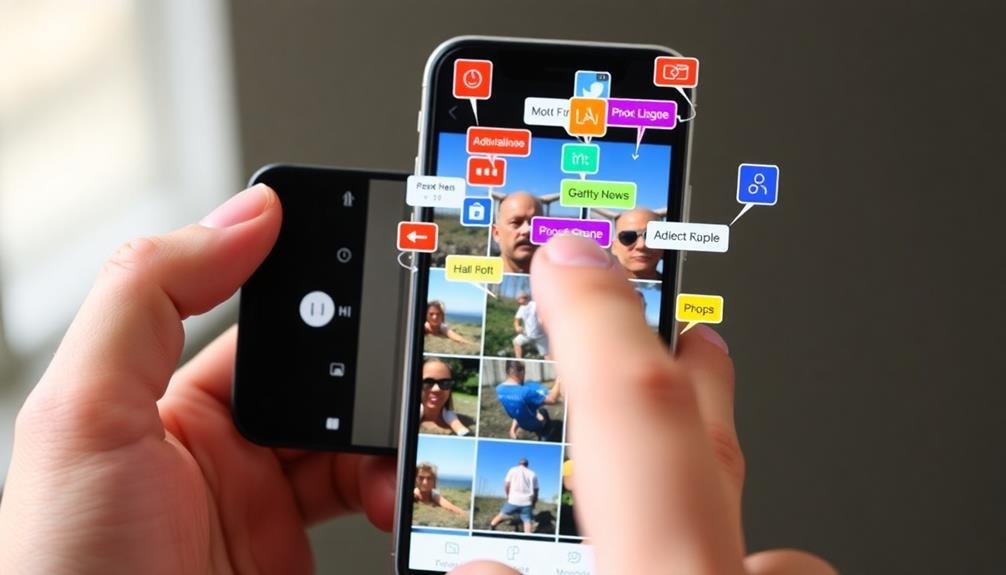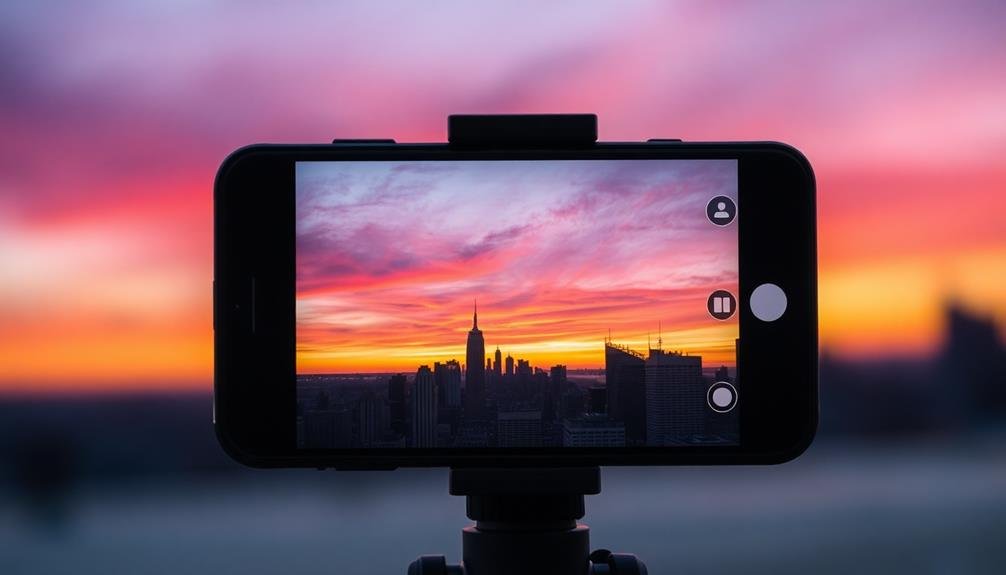The best mobile photo tagging techniques leverage cutting-edge technology to simplify your photo organization. Facial recognition automatically identifies people in your images, while AI-powered systems detect objects and scenes. Location-based tagging adds geographical context, and custom keywords allow for personalized categorization. Voice command tagging offers hands-free convenience, and hashtag integration boosts discoverability. Collaborative methods enable group tagging efforts, while cross-platform consistency guarantees uniformity across devices. Metadata optimization enhances searchability, making it easier to find specific photos. By combining these techniques, you'll create a powerful system for managing your digital memories. Dive deeper to access the full potential of mobile photo tagging.
Facial Recognition Technology

Facial recognition technology is revolutionizing mobile photo tagging. This advanced AI-powered feature can automatically detect and identify faces in your photos, making the tagging process quicker and more efficient. You'll find this technology integrated into many popular photo management apps and social media platforms.
When you enable facial recognition on your mobile device, it'll scan your photo library and create unique "faceprints" for each person. These faceprints are then used to match and tag faces in future photos. As you manually tag people, the system learns and improves its accuracy over time.
You can enhance the effectiveness of facial recognition by:
- Ensuring good lighting in your photos
- Capturing clear, front-facing images of people
- Manually correcting any misidentifications
- Regularly updating your photo management app
While facial recognition streamlines the tagging process, it's important to be aware of privacy concerns. Make sure you understand the app's privacy settings and how your facial data is stored and used.
You can often opt-out of facial recognition features if you prefer manual tagging.
Location-Based Tagging

Location-based tagging is another powerful tool in your mobile photo organization arsenal. It allows you to add geographical information to your images, making it easier to sort and find photos based on where they were taken. Most smartphones automatically embed GPS coordinates into your photos' metadata, but you can also manually add location tags if needed.
To make the most of location-based tagging:
- Enable location services for your camera app to automatically tag photos with precise GPS coordinates.
- Use popular photo-sharing platforms that support location tagging, like Instagram or Flickr, to easily organize and share your geotagged images.
- Create custom location tags for frequently visited places, such as "Home" or "Office," to quickly categorize photos without revealing exact addresses.
Location-based tagging isn't just about organization; it can enhance your photo-sharing experience too. You can create virtual photo albums of your travels, discover new places through other users' geotagged images, or even contribute to location-based photo collections.
AI-Powered Automatic Tagging

AI-powered automatic tagging revolutionizes how you organize your mobile photos.
With object and scene recognition, your device can instantly identify and label elements like beaches, mountains, or animals in your images.
Facial recognition capabilities take this a step further, allowing you to effortlessly tag friends and family members across your photo collection.
Object and Scene Recognition
Harnessing the power of artificial intelligence, object and scene recognition technology has revolutionized mobile photo tagging. This advanced feature allows your smartphone to automatically identify and label various elements within your photos, saving you time and effort in organizing your digital memories.
When you take a photo, the AI analyzes the image and detects objects, landmarks, and scenes. It then applies relevant tags based on its findings, making it easier for you to search and categorize your photos later. For example, if you snap a picture of your dog at the beach, the AI might tag it with "dog," "beach," "ocean," and "sunset" if applicable.
To make the most of object and scene recognition in mobile photo tagging:
- Enable automatic tagging in your photo app settings
- Review and refine AI-generated tags for accuracy
- Use the suggested tags to create custom albums or search for specific photos
As this technology continues to improve, you'll find it increasingly accurate and helpful in managing your ever-growing photo collection.
Facial Recognition Capabilities
Building on the concept of AI-powered recognition, facial recognition technology takes mobile photo tagging to the next level. This advanced feature allows your smartphone to identify and tag individuals in your photos automatically. As you snap pictures, the AI analyzes facial features, comparing them to a database of known faces from your contacts or previously tagged images.
You'll find that facial recognition capabilities have improved considerably in recent years. Modern algorithms can detect faces even in challenging lighting conditions or when partially obscured. They're also able to recognize the same person across different photos, regardless of changes in hairstyle, facial hair, or aging.
To make the most of this feature, confirm you've enabled it in your phone's settings and that your contacts have associated profile pictures. As you use the feature more, it'll learn and improve its accuracy. You can also manually confirm or correct tags to help train the AI further.
Custom Keyword Creation

Creating custom keywords is a powerful way to personalize your photo tagging system. It allows you to organize your images in a way that's meaningful to you and makes them easier to find later. When creating custom keywords, think about the categories that matter most to you, such as events, locations, or themes. You'll want to choose words that are specific enough to be useful but not so narrow that you'll forget them.
To make the most of custom keyword creation:
- Use a consistent naming convention for your keywords, like starting location tags with "loc_" or event tags with "event_".
- Create hierarchical keyword structures, such as "family > cousins > John" to enable both broad and specific searches.
- Include emotion-based keywords to capture the mood of your photos, like "happy," "nostalgic," or "exciting."
Don't hesitate to revise and refine your keyword system as you use it. You'll likely discover new categories or more efficient ways to tag your photos over time.
Voice Command Tagging

Voice command tagging leverages your smartphone's speech recognition capabilities to streamline photo organization.
You'll find this method particularly useful when your hands are occupied or you're multitasking.
As voice recognition technology improves, you can expect increased accuracy and a more seamless tagging experience.
Voice Recognition Accuracy
Accuracy is paramount when it comes to voice command tagging for mobile photos. You'll want to guarantee that your voice commands are correctly interpreted to avoid mislabeling or missing important tags. To improve voice recognition accuracy, speak clearly and at a moderate pace. Minimize background noise when tagging, as this can interfere with the system's ability to understand your commands.
Modern smartphones have made significant strides in voice recognition technology, but there's still room for improvement. You can enhance accuracy by training your device to recognize your voice better. This often involves using the voice assistant frequently and correcting any mistakes it makes.
To maximize voice recognition accuracy for photo tagging:
- Use simple, concise tags that are easy to pronounce
- Create custom voice shortcuts for frequently used tags
- Regularly update your device's software to benefit from the latest voice recognition improvements
Remember that voice recognition accuracy can vary depending on your accent, speech patterns, and the complexity of the tags you're using. If you're consistently experiencing issues, consider using a combination of voice and manual tagging methods to guarantee your photos are properly organized and easily searchable.
Hands-Free Tagging Benefits
Convenience is at the heart of hands-free tagging through voice commands. You'll find this method particularly useful when you're multitasking or in situations where typing isn't practical. By simply speaking your tags, you can quickly organize your photos without interrupting your workflow or activities.
Voice tagging allows you to maintain your focus on the subject or scene you're photographing. You won't need to shift your attention to your device's screen, reducing the risk of missing important moments. This seamless integration of tagging into your photography process can lead to more thorough and accurate metadata for your images.
Safety is another key benefit of hands-free tagging. When you're in challenging environments or handling equipment, voice commands eliminate the need to fumble with your device. This can be especially vital in outdoor or adventure photography settings.
Accessibility is improved for users with limited mobility or visual impairments. Voice tagging opens up photo organization to a wider range of photographers, making the process more inclusive and user-friendly for everyone.
Event-Based Categorization

Event-based categorization frequently serves as a powerful method for organizing your mobile photos. By grouping images based on specific occasions or activities, you'll create a logical structure that makes it easier to find and relive your memories.
This approach works well for both personal and professional use, allowing you to quickly locate photos from weddings, vacations, business conferences, or family gatherings.
To implement event-based categorization effectively, consider these tips:
- Use descriptive event names: Choose clear, specific titles for your events, such as "Sarah's 30th Birthday Party" or "2023 Company Retreat," to make searching easier.
- Create sub-categories: For larger events, break them down into smaller segments, like "Day 1," "Day 2," or "Ceremony," "Reception," to further organize your photos.
- Utilize date ranges: Assign start and end dates to your events, helping you narrow down searches and maintain chronological order.
Color and Object Detection

Modern mobile photo tagging techniques have advanced beyond simple event categorization, incorporating powerful AI-driven features like color and object detection. These technologies analyze your photos' visual content, automatically identifying colors, objects, and even specific items or landmarks.
Color detection allows you to search for photos based on dominant hues or color schemes. You'll find it easier to locate that vibrant sunset shot or your collection of blue-themed images.
Object detection goes a step further, recognizing common items like cars, animals, or food. This feature enables you to quickly find photos containing specific elements without manually tagging each one.
Some advanced apps can identify specific breeds of animals, types of food, or even particular landmarks. You'll be able to search for "golden retriever" or "Eiffel Tower" without adding these tags yourself.
These AI-powered tools continuously improve, learning from vast datasets to enhance their accuracy.
To make the most of these features, verify your photo app is up-to-date and has permission to access your photos. You may need to enable specific settings or run initial scans to fully utilize color and object detection capabilities.
Time and Date Stamping

Time and date stamping enhances your photo organization by automatically capturing timestamps when you take pictures.
You can customize date formats to suit your preferences, ensuring consistency across your photo library.
Advanced metadata embedding techniques allow you to include detailed temporal information within your image files, making future sorting and searching a breeze.
Automatic Timestamp Capture
In addition to manual tagging, automatic timestamp capture has become an essential feature for mobile photo organization. This technology guarantees that every photo you take is automatically tagged with the exact date and time it was captured. Most modern smartphones and digital cameras come equipped with this feature, making it easier for you to sort and search your photos chronologically.
Automatic timestamp capture offers several benefits:
- Accurate record-keeping: You'll never have to guess when a photo was taken, as the exact date and time are embedded in the image file.
- Easy sorting: Your photo gallery app can automatically organize pictures by date, creating a timeline of your memories.
- Improved searchability: You can quickly find photos from specific events or time periods without manually tagging each image.
To make the most of automatic timestamp capture, verify your device's clock is set correctly. If you're traveling across time zones, update your phone's settings to reflect the local time.
Some apps even allow you to adjust timestamps after the fact, which can be helpful if you forget to change your device's clock while traveling. By leveraging this feature, you'll create a more organized and easily navigable photo collection.
Customizing Date Formats
Building on the automatic timestamp feature, many photo apps now offer customizable date formats for time and date stamping. This flexibility allows you to tailor the appearance of timestamps to your preferences or specific needs. You can typically choose from a variety of formats, such as MM/DD/YYYY, DD/MM/YYYY, or YYYY-MM-DD for dates, and 12-hour or 24-hour formats for time.
Some apps even let you create custom formats, enabling you to include additional information like day of the week or time zone. You'll often find options to adjust the font, size, color, and position of the timestamp on your photos. This customization helps maintain consistency across your photo collection or aligns with your personal aesthetic.
When customizing date formats, consider the purpose of your photos. For personal memories, you might prefer a more casual format, while professional or documentary photos may require a standardized, precise format.
Remember that some regions use different date conventions, so if you're sharing photos internationally, choosing a universally understood format can be beneficial. By taking advantage of these customization options, you'll guarantee your photo timestamps are both functional and visually appealing.
Metadata Embedding Techniques
Metadata's role in photo tagging goes beyond visible timestamps, offering a powerful way to embed time and date information directly into image files. When you take a photo on your mobile device, it automatically captures this data in the EXIF (Exchangeable Image File Format) metadata. This invisible information stays with the image, even when you share or transfer it.
To make the most of metadata embedding for time and date stamping, you'll want to:
- Guarantee your device's time and date settings are accurate
- Use apps that can read and display EXIF data
- Learn how to edit metadata if needed
You can leverage this embedded information to sort, search, and organize your photos more efficiently. Many photo management apps and cloud services use this metadata to create timelines or group images by date.
It's a seamless way to keep your memories organized without manually tagging each photo. Remember, while visible timestamps can be altered or removed, embedded metadata provides a more permanent and reliable record of when your photos were taken.
Mood and Emotion Tagging

Smiles, frowns, and everything in between can now be captured and tagged in your mobile photos. Mood and emotion tagging allows you to categorize images based on the feelings they evoke or the emotions displayed by subjects. This technique enhances your ability to search and organize photos, making it easier to relive specific moments or create themed albums.
To effectively tag moods and emotions, consider the overall atmosphere of the image, facial expressions, body language, and color tones. Many photo apps now offer AI-powered emotion recognition, automatically suggesting tags based on detected facial expressions. However, you can also manually add custom emotion tags to capture more nuanced feelings.
Here's a quick guide to common mood and emotion tags:
| Positive Emotions | Negative Emotions |
|---|---|
| Joy | Sadness |
| Excitement | Anger |
| Love | Fear |
| Contentment | Frustration |
Hashtag Integration

Hashtags have become an integral part of photo tagging, seamlessly bridging the gap between mobile galleries and social media platforms. When you integrate hashtags into your mobile photo tagging strategy, you're not just organizing your images; you're creating a pathway for discovery and engagement.
By adding relevant hashtags to your photos, you're making them searchable and accessible to a wider audience, both within your device and across various social networks.
To effectively use hashtags in your mobile photo tagging:
- Use a mix of popular and niche hashtags to balance reach and relevance
- Create personal hashtags for specific events or themes in your life
- Research trending hashtags in your interest areas to increase visibility
Don't overcrowd your tags with hashtags; instead, choose them thoughtfully. Many mobile photo apps now offer hashtag suggestions based on image content or your past usage, making the process more efficient.
You can also use hashtag generators to find relevant tags for your photos. Remember, hashtags aren't just for social media posts; they can be powerful tools for organizing your personal photo collection on your mobile device as well.
Collaborative Tagging Methods

Teamwork makes the dream work, especially when it comes to photo tagging. Collaborative tagging methods allow you to harness the power of your social network to efficiently and accurately tag your mobile photos. By involving friends, family, or colleagues in the tagging process, you'll not only save time but also improve the quality and relevance of your tags.
Start by using apps that offer shared albums or group tagging features. These platforms allow multiple users to add tags, comments, and even facial recognition data to your photos.
You can also create a shared tagging system with your circle, where everyone agrees on specific tags or categories to use consistently across your collective photo libraries.
Consider using crowdsourcing platforms that leverage the wisdom of the masses to tag your photos. These services often employ AI algorithms combined with human input to generate thorough and accurate tags.
Don't forget to reciprocate by contributing to others' tagging efforts, creating a mutually beneficial ecosystem.
Lastly, explore collaborative geotagging methods. By sharing location data with your network, you can collectively build a rich database of tagged locations, making it easier to organize and search for photos based on where they were taken.
Cross-Platform Tagging Consistency

With the multitude of photo apps and platforms available, maintaining consistent tagging across different services can be challenging.
You'll want to develop a strategy to guarantee your tags remain uniform, regardless of where you're sharing or storing your photos. This consistency will make it easier to search for and organize your images across various platforms.
To achieve cross-platform tagging consistency, consider using a standardized tagging system. Create a personal set of commonly used tags and stick to them across all platforms. You can also use tagging apps that sync with multiple services, allowing you to apply the same tags to photos on different platforms simultaneously.
Here are three tips to help you maintain consistent tagging across platforms:
- Use a consistent naming convention for your tags (e.g., camelCase or hyphenated-words)
- Create a master list of your most frequently used tags and refer to it when tagging photos
- Regularly review and update your tags across all platforms to guarantee uniformity
Metadata Optimization Techniques

Optimizing your photo metadata goes beyond consistent tagging across platforms. To maximize the effectiveness of your mobile photo tagging, you'll need to employ several metadata optimization techniques.
Start by using descriptive and specific tags that accurately represent the image content. Include relevant keywords, locations, and dates to enhance searchability.
Don't overlook the power of geotags. Enable location services on your device to automatically add GPS coordinates to your photos. This information can be invaluable for organizing and searching your collection later.
Consider implementing a hierarchical tagging system. Use broad categories for general sorting and more specific tags for detailed searches. For example, tag a photo with "nature," "forest," and "redwood trees" to cover multiple levels of specificity.
Utilize face recognition features in your photo management apps. Tagging people in your images not only helps with organization but also improves the accuracy of AI-powered search functions.
Regularly review and update your tags to guarantee they remain relevant and useful. As your photo collection grows, you may need to refine your tagging strategy to maintain efficiency and effectiveness.
Frequently Asked Questions
How Can I Protect My Privacy When Using Photo Tagging Features?
To protect your privacy with photo tagging, you should review and adjust your app settings regularly. Don't tag strangers, limit who can tag you, and use privacy controls. Consider disabling facial recognition and being selective about sharing photos online.
Are There Any Legal Considerations When Tagging People in Photos?
You should consider privacy laws and consent when tagging others in photos. It's best to get permission before tagging someone, especially in public settings. Be aware of potential copyright issues and respect individuals' right to control their image.
Can Photo Tagging Affect My Device's Battery Life or Performance?
Yes, photo tagging can impact your device's battery life and performance. It uses processing power and may require internet connectivity. Excessive tagging or running tagging apps in the background can drain your battery faster and slow down your device.
How Do I Remove or Edit Incorrect Tags From My Photos?
You can easily remove or edit incorrect tags from your photos. Open your device's photo app, select the image, and look for tag editing options. You'll typically find choices to delete tags or modify existing ones.
What's the Best Way to Organize Tagged Photos for Easy Retrieval?
Create albums based on tags, use nested folders, and utilize smart albums that automatically group photos. Consistently apply tags, consider using a naming convention, and leverage your photo app's search function to quickly find tagged images.
In Summary
You've got a range of powerful tools at your fingertips for mobile photo tagging. From facial recognition to AI-powered automation, you're equipped to organize your photos efficiently. Don't forget to leverage location data, custom keywords, and voice commands for quick tagging. Embrace hashtags and collaborative methods to enhance discoverability. Remember to maintain consistency across platforms and optimize metadata for the best results. With these techniques, you'll master mobile photo tagging in no time.





Leave a Reply